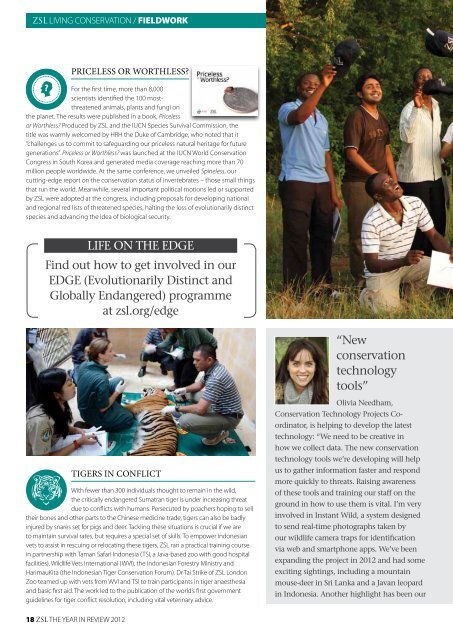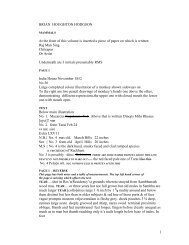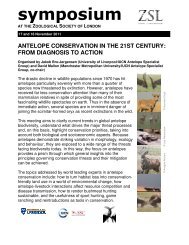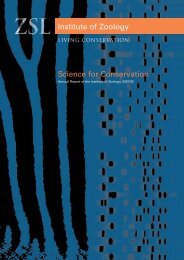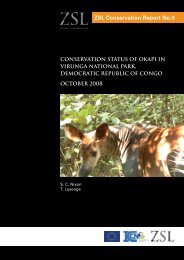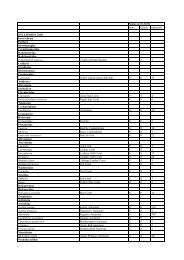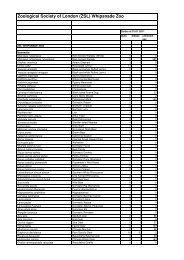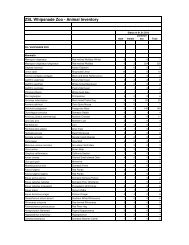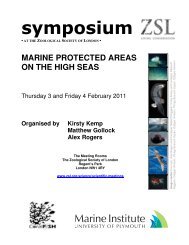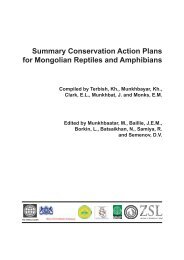ZSL - The Year in Review 2012 - Zoological Society of London
ZSL - The Year in Review 2012 - Zoological Society of London
ZSL - The Year in Review 2012 - Zoological Society of London
You also want an ePaper? Increase the reach of your titles
YUMPU automatically turns print PDFs into web optimized ePapers that Google loves.
<strong>ZSL</strong> Liv<strong>in</strong>g conservation / fieldwork<br />
Priceless or worthless?<br />
For the first time, more than 8,000<br />
scientists identified the 100 mostthreatened<br />
animals, plants and fungi on<br />
the planet. <strong>The</strong> results were published <strong>in</strong> a book, Priceless<br />
or Worthless? Produced by <strong>ZSL</strong> and the IUCN Species Survival Commission, the<br />
title was warmly welcomed by HRH the Duke <strong>of</strong> Cambridge, who noted that it<br />
“challenges us to commit to safeguard<strong>in</strong>g our priceless natural heritage for future<br />
generations”. Priceless or Worthless? was launched at the IUCN World Conservation<br />
Congress <strong>in</strong> South Korea and generated media coverage reach<strong>in</strong>g more than 70<br />
million people worldwide. At the same conference, we unveiled Sp<strong>in</strong>eless, our<br />
cutt<strong>in</strong>g-edge report on the conservation status <strong>of</strong> <strong>in</strong>vertebrates – those small th<strong>in</strong>gs<br />
that run the world. Meanwhile, several important political motions led or supported<br />
by <strong>ZSL</strong> were adopted at the congress, <strong>in</strong>clud<strong>in</strong>g proposals for develop<strong>in</strong>g national<br />
and regional red lists <strong>of</strong> threatened species, halt<strong>in</strong>g the loss <strong>of</strong> evolutionarily dist<strong>in</strong>ct<br />
species and advanc<strong>in</strong>g the idea <strong>of</strong> biological security.<br />
life on the edge<br />
F<strong>in</strong>d out how to get <strong>in</strong>volved <strong>in</strong> our<br />
EDGE (Evolutionarily Dist<strong>in</strong>ct and<br />
Globally Endangered) programme<br />
at zsl.org/edge<br />
“New<br />
conservation<br />
technology<br />
tools”<br />
Tigers <strong>in</strong> conflict<br />
With fewer than 300 <strong>in</strong>dividuals thought to rema<strong>in</strong> <strong>in</strong> the wild,<br />
the critically endangered Sumatran tiger is under <strong>in</strong>creas<strong>in</strong>g threat<br />
due to conflicts with humans. Persecuted by poachers hop<strong>in</strong>g to sell<br />
their bones and other parts to the Ch<strong>in</strong>ese medic<strong>in</strong>e trade, tigers can also be badly<br />
<strong>in</strong>jured by snares set for pigs and deer. Tackl<strong>in</strong>g these situations is crucial if we are<br />
to ma<strong>in</strong>ta<strong>in</strong> survival rates, but requires a special set <strong>of</strong> skills. To empower Indonesian<br />
vets to assist <strong>in</strong> rescu<strong>in</strong>g or relocat<strong>in</strong>g these tigers, <strong>ZSL</strong> ran a practical tra<strong>in</strong><strong>in</strong>g course<br />
<strong>in</strong> partnership with Taman Safari Indonesia (TSI, a Java-based zoo with good hospital<br />
facilities), Wildlife Vets International (WVI), the Indonesian Forestry M<strong>in</strong>istry and<br />
HarimauKita (the Indonesian Tiger Conservation Forum). Dr Tai Strike <strong>of</strong> <strong>ZSL</strong> <strong>London</strong><br />
Zoo teamed up with vets from WVI and TSI to tra<strong>in</strong> participants <strong>in</strong> tiger anaesthesia<br />
and basic first aid. <strong>The</strong> work led to the publication <strong>of</strong> the world’s first government<br />
guidel<strong>in</strong>es for tiger conflict resolution, <strong>in</strong>clud<strong>in</strong>g vital veter<strong>in</strong>ary advice.<br />
Olivia Needham,<br />
Conservation Technology Projects Coord<strong>in</strong>ator,<br />
is help<strong>in</strong>g to develop the latest<br />
technology: “We need to be creative <strong>in</strong><br />
how we collect data. <strong>The</strong> new conservation<br />
technology tools we’re develop<strong>in</strong>g will help<br />
us to gather <strong>in</strong>formation faster and respond<br />
more quickly to threats. Rais<strong>in</strong>g awareness<br />
<strong>of</strong> these tools and tra<strong>in</strong><strong>in</strong>g our staff on the<br />
ground <strong>in</strong> how to use them is vital. I’m very<br />
<strong>in</strong>volved <strong>in</strong> Instant Wild, a system designed<br />
to send real-time photographs taken by<br />
our wildlife camera traps for identification<br />
via web and smartphone apps. We’ve been<br />
expand<strong>in</strong>g the project <strong>in</strong> <strong>2012</strong> and had some<br />
excit<strong>in</strong>g sight<strong>in</strong>gs, <strong>in</strong>clud<strong>in</strong>g a mounta<strong>in</strong><br />
mouse-deer <strong>in</strong> Sri Lanka and a Javan leopard<br />
<strong>in</strong> Indonesia. Another highlight has been our<br />
18 <strong>ZSL</strong> <strong>The</strong> year <strong>in</strong> review <strong>2012</strong>


